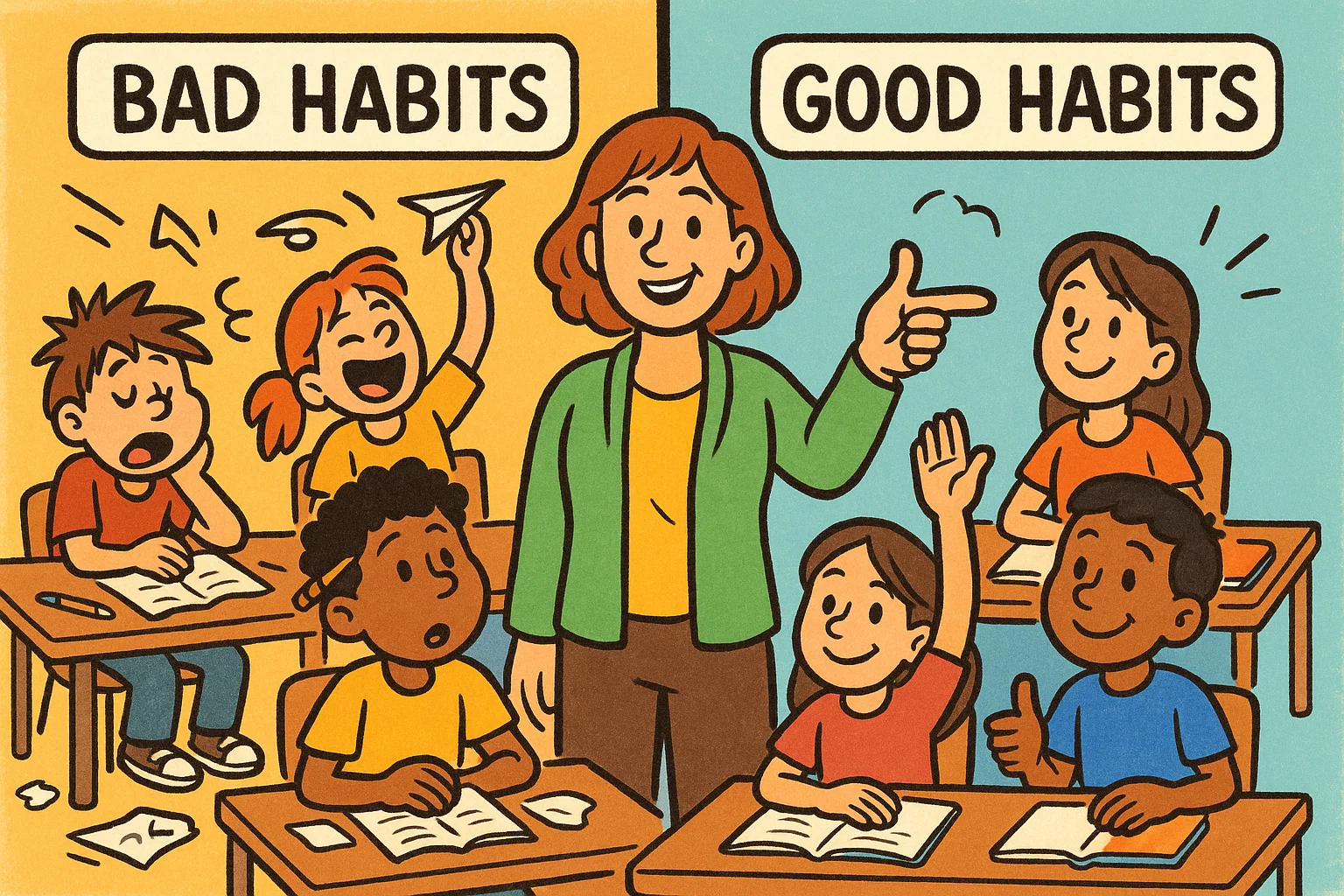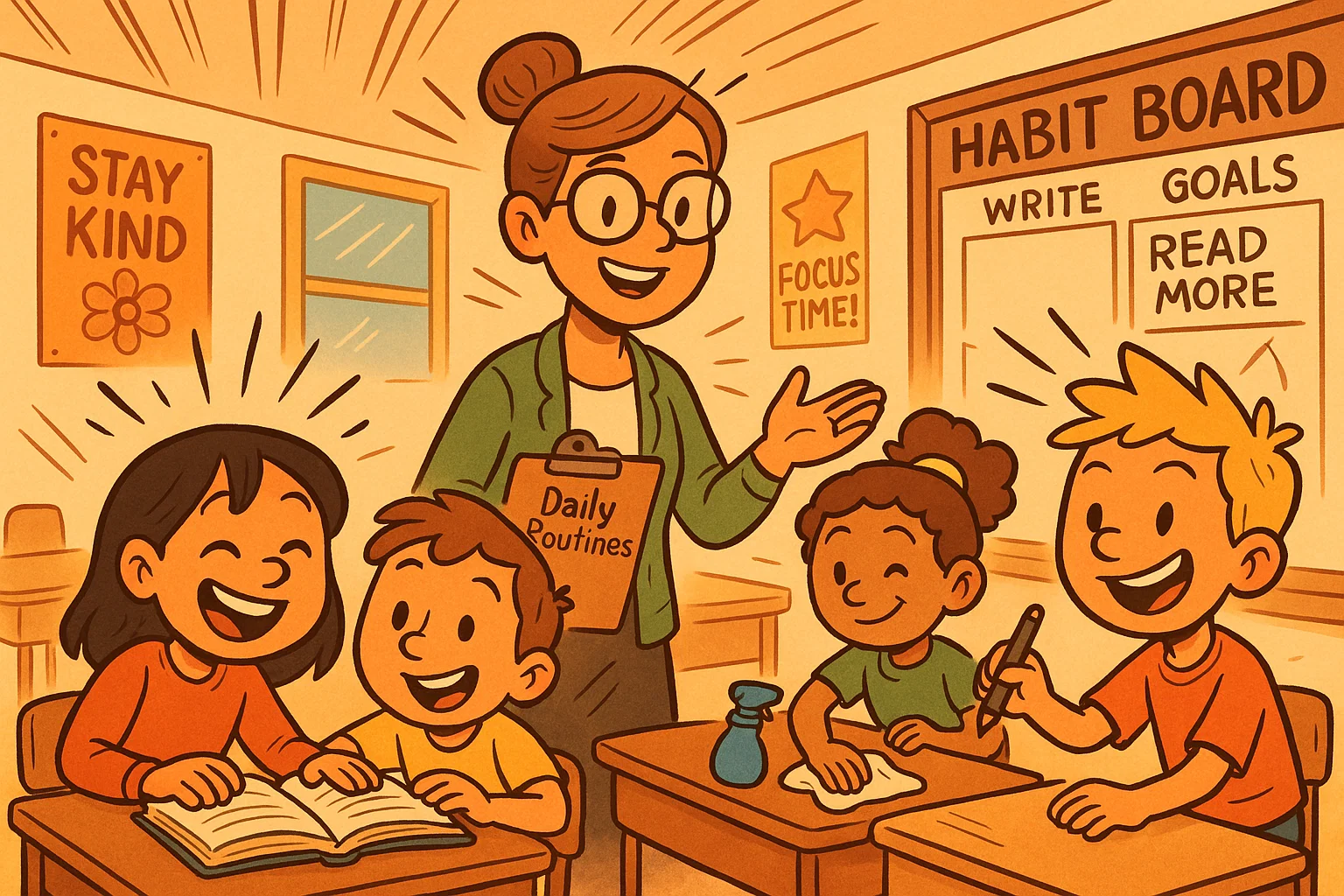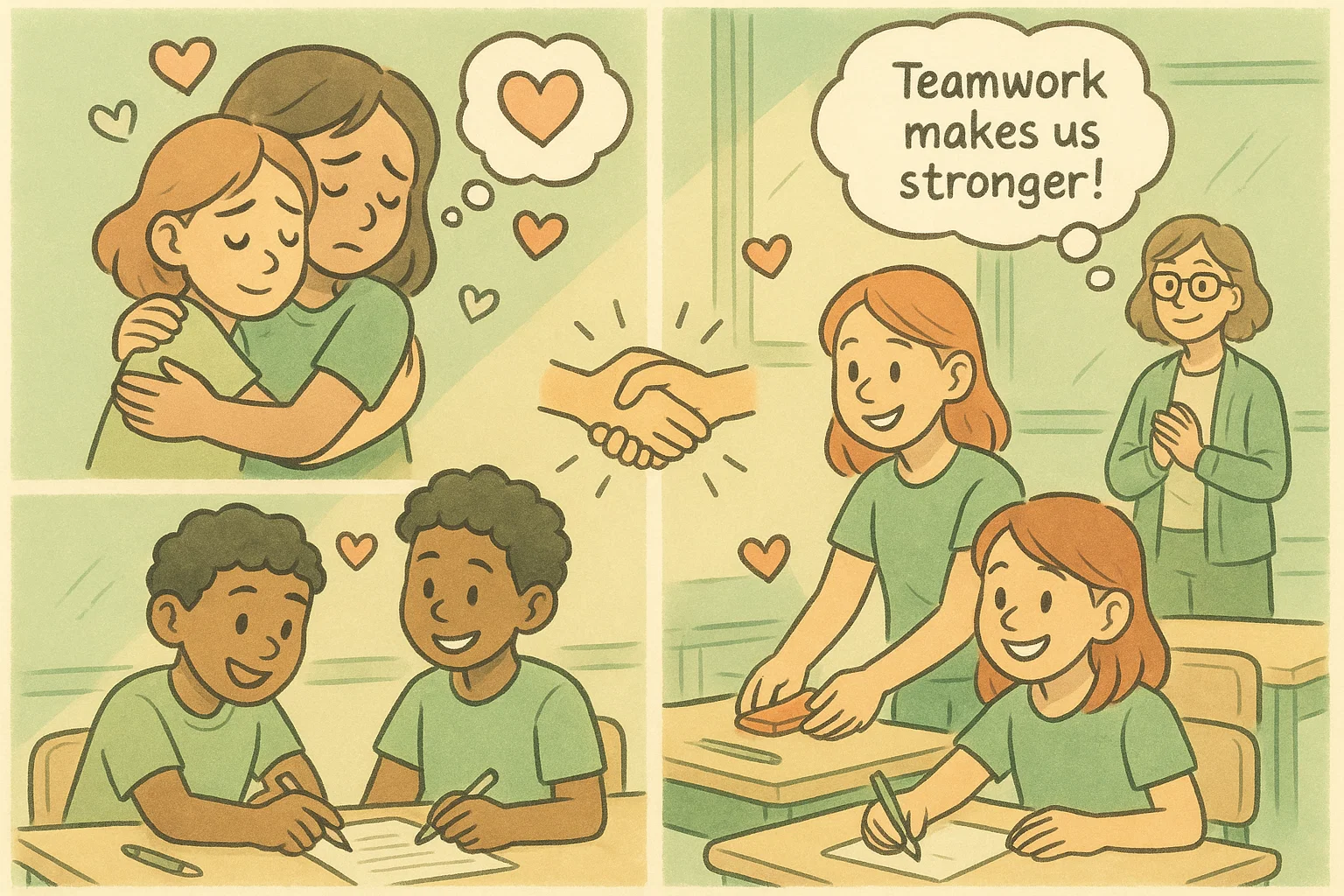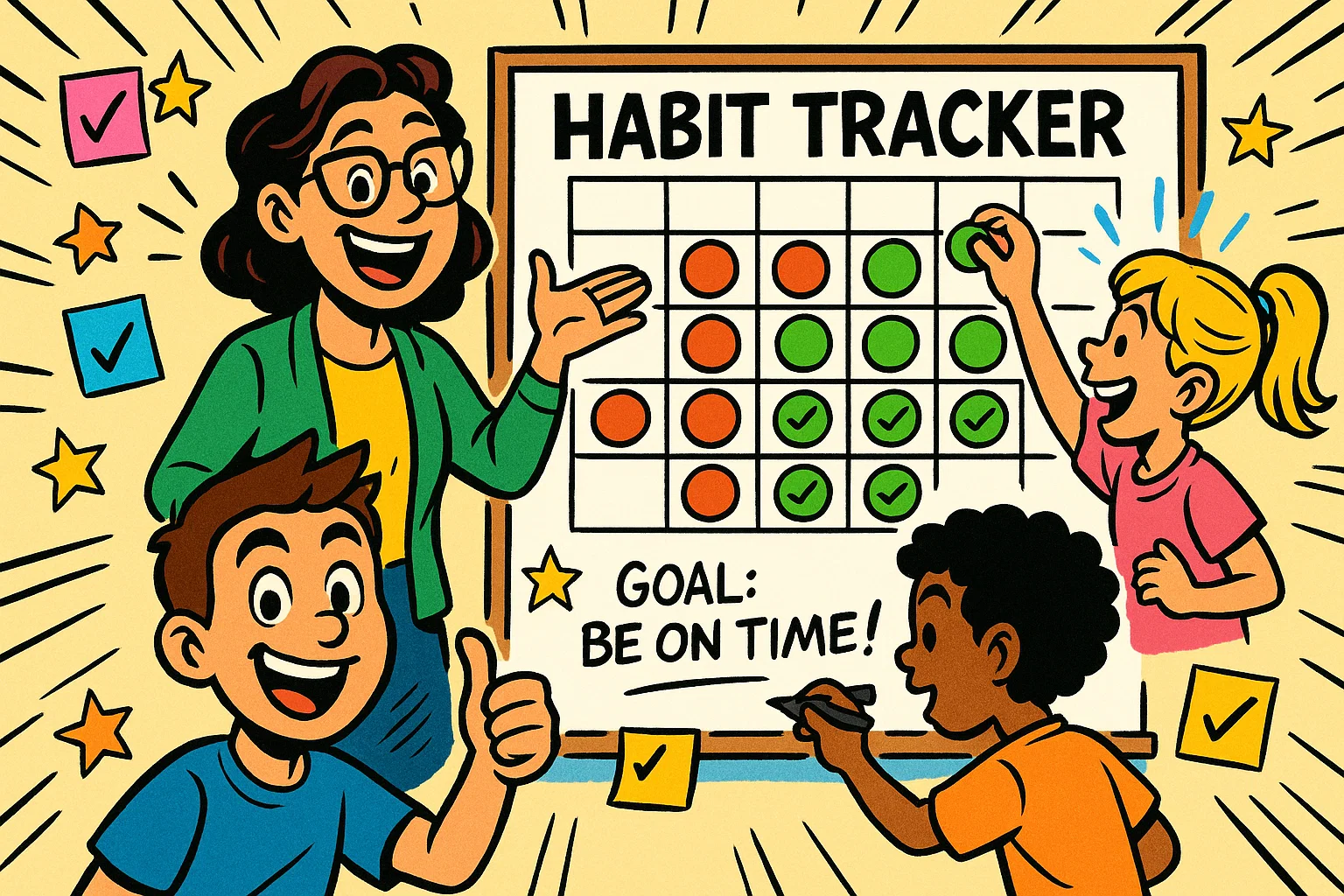Good Habits in Classroom: Building Positive Routines for Students

Cultivating positive habits in the classroom is one of the most effective ways to build a strong foundation for student success. It goes far beyond enforcing discipline; it’s about helping students develop self-regulation and equipping them with essential life skills that will serve them well in school and beyond. When students understand and internalize effective routines, the classroom environment becomes a space where focus grows and disruption is minimized.
For educators and parents alike, the goal is not only to teach subjects but also to foster independent, confident individuals. This requires a holistic approach—combining structured, teacher-led strategies with student-driven practices that build personal responsibility. By nurturing a few key positive habits early on, we help students manage challenges, reduce stress, and grow into capable, well-rounded members of society.
Why Good Habits Matter for Students

Consistent, positive routines are the silent architecture of achievement. It removes the mental friction of constantly deciding what to do next, freeing up cognitive resources for deeper learning and creativity. Research shows that habits, those small, repeated actions, are a powerful predictor of academic success, motivation, emotional balance, and overall classroom harmony.
Role of Habits in Personal Growth
Small, daily routines are the bedrock of personal growth. When students develop good habits such as preparing for class the night before or setting aside a dedicated, screen-free study time, they are essentially training their minds for self-discipline. This cultivation of self-regulation directly improves focus, responsibility, and emotional intelligence. For instance, the simple habit of writing down tasks allows students to understand and externalize their planning, reducing anxiety and increasing their sense of control over their schoolwork.
Academic and Social Benefits
Habits directly influence learning outcomes and social interactions. A student who has the habit of writing down assignments is less likely to miss deadlines, while one who practices respecting others naturally excels in group projects and peer collaboration.
| Habit Area | Academic Benefit | Social/Emotional Benefit |
| Organization | Less time wasted searching; easier study recall. | Reduces stress levels; fosters a calm approach. |
| Active Listening | Better understanding of instructions; improved retention. | Shows respect for teachers and peers; builds stronger interpersonal skills. |
| Consistent Study | Higher test scores; reduced last-minute cramming. | Boosts self-discipline; helps students understand cause and effect. |
Long-Term Impact of Early Habit Formation
The good habits children learn today lay the foundation for life’s biggest challenges. Recent research suggests that students who develop good habits early on—like effective time management, a growth mindset, and effective communication—are significantly better equipped for the rigors of university, the complexity of a career, and personal life management. These fundamental practices lay the groundwork for them to become high-functioning adults in school and beyond.
Core Habits for Success in Classroom
Instilling a few fundamental positive habit practices can drastically improve every student’s classroom performance, positive behaviour, and engagement. These are not complex traits but rather simple, actionable steps students learn to embed in their day-to-day life.
Here are the top 10 good habits crucial for student success:
- Punctuality and Time Management: Arriving on time and using a planner.
- Active Participation: Contributing meaningfully to discussions and answering questions.
- Respect for Teachers and Peers: Demonstrating kindness and active listening.
- Consistent Study Routine: Having a planned time for study habits each day.
- Cleanliness and Organization: Keeping their surroundings tidy.
- Positive Attitude and Growth Mindset: Embracing challenges and learning from mistakes.
- Self-Regulation: Managing emotions without disruption.
- Preparation: Having all necessary materials ready before class.
- Asking for Help: Recognizing when assistance is needed and seeking it out.
- Screen Time Management: Balancing digital use with screen-free activities.
Consistent Study Routine
A consistent, planned schedule for study habits enhances retention and drastically reduces pre-exam stress levels. Parents and teachers can encourage students to set a predictable time each day—even a short one—to review notes or start homework, making it a natural part of their daily routine.
Cleanliness and Organization
Keeping their surroundings tidy—from their desk to their backpack—is an important life lesson in cleanliness and efficiency. An organized space leads to an organized mind. A clear desk allows students to focus better, minimizing disruption and maximizing concentration during learning time.
Positive Attitude and Growth Mindset
The ability to look at failure not as a final judgment but as a learning opportunity is the essence of the growth mindset. Teachers and parents should teach students to use positive affirmations, embrace challenges, and persevere when facing a difficult habit. This optimism is central to becoming confident individuals.
Developing Good Habits Through Classroom Activities

Teachers are the primary architects of a positive classroom culture. They can teach good behaviour by creating a structured yet nurturing learning environment.
Modeling Ideal Behavior
The most powerful tool a teacher has is their own example and consistency. Teachers should model the very habits that lead to success: punctuality, organization, respect, and a calm approach to problem-solving. If a teacher handles a challenge with self-regulation and grace, they are providing a powerful, evidence-informed lesson in positive behaviour.
Creating Stable Daily Routines
Structure creates safety and predictability. Consistent timing for transitions, clear visual aids for task completion, and predictable rules help children to learn what is expected. This predictable structure helps kids to learn to embed new routines.
Encouraging Initiative and Responsibility
Giving students ownership of their learning and environment is crucial. This might involve:
- Self-Check Systems: Letting students use a checklist before handing in schoolwork.
- Small Leadership Tasks: Assigning a student to be the “material distributor” or “line leader.”
- Peer Tutoring: Encouraging older students to become mentors for younger peers.
Reward Systems and Positive Reinforcement
Positive reinforcement should focus on effort and the process of building habits, not just the outcome. Recognizing consistency with specific praise builds intrinsic motivation far better than external rewards.
Reflection Time and Self-Assessment
Providing a moment for quiet thought, perhaps through a daily or weekly reflection journal or an “end-of-day reflections,” helps students deepen self-awareness.
Reflection Prompts:
- What is one good habit I practiced successfully today?
- What was one moment of disruption, and what could I have done differently (self-regulation)?
- What is one thing I am grateful for (practicing gratitude)?
Collaboration Between Teachers and Parents
For habits to stick, there must be consistency between school and home. Parents and teachers must stay aligned, understanding that positive habits form the foundation for a child’s learning and life.
Setting Shared Goals
Parents and teachers can align expectations. If the school is focusing on completing homework by 7:00 PM, parents can reinforce this by setting a family study time. This shared commitment is an evidence-informed approach to behavioural change.
Communicating Progress
Open feedback loops are essential. Simple progress reports, quick notes, or digital tools allow students and parents to track progress. The goal is to nurture, not criticize, and reinforce the belief that habits lay the foundation for success.
Reinforcing Habits at Home
Parents are vital partners. They can help their child by suggesting home-based routines that mirror classroom expectations:
- Organization Checklists: A checklist for packing the backpack and lunchbox.
- Screen Time Limits: Establishing clear boundaries for screen time vs. screen-free activities.
- Reading Habit: Scheduling 20 minutes of reading at home each day.
Building Emotional and Social Habits

Developing good habits around emotional literacy and strong interpersonal skills is just as important as academic learning. These healthy habits nurture a student’s whole self, creating well-rounded individuals.
Practicing Gratitude and Mindfulness
Simple practices like a “Gratitude Jar” or taking a few minutes each day for mindful breathing can build emotional resilience and a sense of calm. This cultivation of appreciation helps students become more focused and grateful.
Helping Others and Teamwork
Structured group projects and peer mentoring opportunities teach students invaluable life lessons in cooperation and empathy. When students are encouraged to help a struggling classmate, they are solidifying the habit of kindness and contributing to a positive classroom environment.
Managing Emotions and Stress
This involves teaching good self-regulation strategies. These are life lessons students learn to embed in their daily lives.
Self-Regulation Strategies:
- The “Take 5” Breath: Simple, deep-breathing exercises.
- Talking Circles: Structured time for students to express feelings without interruption.
- Identifying Feelings: Using a visual chart to name and accept emotions.
Encouraging Curiosity and Reflection
Educators should foster a love for lifelong learning. This means promoting critical thinking, encouraging students to ask and explore questions with curiosity, and maintaining reflective learning journals.
Classroom Strategies to Maintain Habits

Consistency is the ultimate key to transforming an intention into a habit. Parents and teachers must work together to maintain momentum throughout the year.
Regular Feedback and Reflection
Ongoing conversations about what routines work best, and why, help children to internalize the value of the habit, not just the rule. This is where a teacher’s expertise is paramount.
Habit Tracking Charts or Journals
Visual aids provide a powerful representation of success. Habit tracking charts in the classroom or individual journals can use:
- Stickers or Checkmarks for daily habit completion.
- Progress bars for the whole class on a shared goal (e.g., Classroom Organization Challenge).
- Weekly reflection on which habits help the most with schoolwork.
Integrating Habits into Lesson Plans
Habit practice should not be isolated. For example, during a science lesson, a teacher might reinforce the habit of cleanliness by ensuring all lab materials are cleaned and organized immediately after use. This makes the life lessons a part of every student’s curriculum.
Adjusting Strategies for Different Age Groups
The approach must change as the child matures:
| Age Group | Focus on Habit | Key Strategy |
| Primary (K-2) | Cleanliness & Respect | Simple visual aids and highly predictable routines. |
| Middle School (6-8) | Time Management & Organization | Use of planners/agendas, and goal-setting for study habits. |
| High School (9-12) | Self-Discipline & Growth Mindset | Focus on long-term planning, stress management, and intrinsic motivation. |
Conclusion: Importance of Good Habits in Classroom for Student Growth and Success
The commitment to developing good habits in the classroom is a long-term investment that yields compounding returns. As child development and parenting experts emphasize, these positive routines shape not only academic excellence but also emotional resilience and social aptitude. Educators and parents share the vital, non-negotiable role of being steadfast guides, teaching children how to cultivate positive habits that will see them thrive in school and beyond and become successful, well-adjusted adults. By consciously instilling these positive habit structures, we lay the foundation for a future of lifelong learning and meaningful contribution.
Frequently Asked Questions
What are examples of good classroom habits?
Examples of good classroom habits include arriving on time and prepared, actively listening and respecting others, using a planner for time management, maintaining an organized workspace, and setting aside regular study time.
How can teachers teach habits effectively?
Teachers can effectively teach students by using an evidence-informed approach: 1) Model the desired positive behaviour consistently; 2) Establish a clear, predictable daily routine; 3) Use positive reinforcement focused on the effort; and 4) Provide structured opportunities for reflection and self-assessment.
Why are habits important for students’ future success?
Habits help students become self-disciplined, resilient, and better at time management. These are the key traits employers and universities look for. Skills like respecting others, consistent effort, and a growth mindset are fundamental for career readiness, managing stress levels, and navigating the complexities of adult life.
How can parents encourage classroom habits at home?
Parents can help their child by creating a supportive, structured environment at home. This includes: setting a consistent, screen-free time for homework; helping them organise their belongings the night before; and modeling good behavior, such as completing their own tasks with focus and a positive attitude. This consistency reinforces the importance of routine taught in a positive classroom environment.
